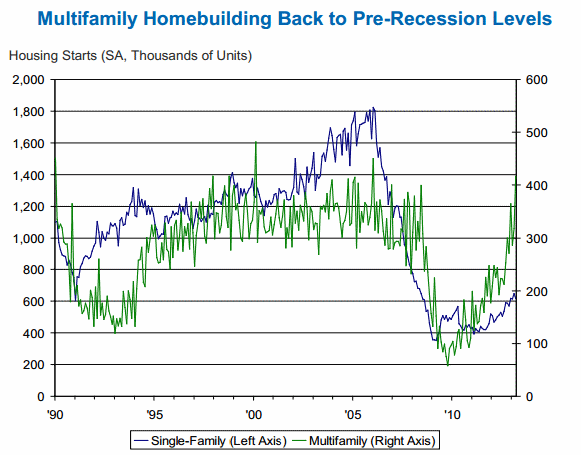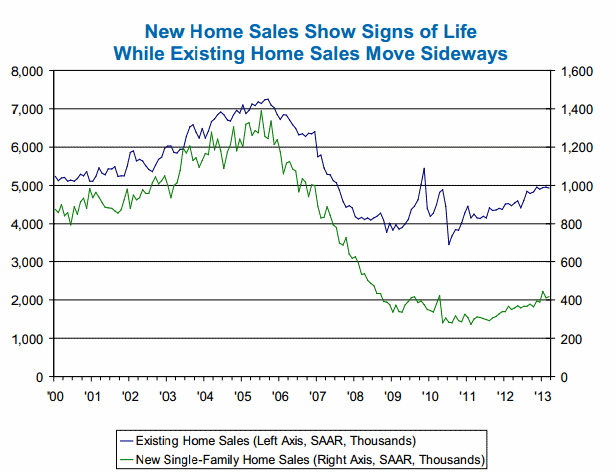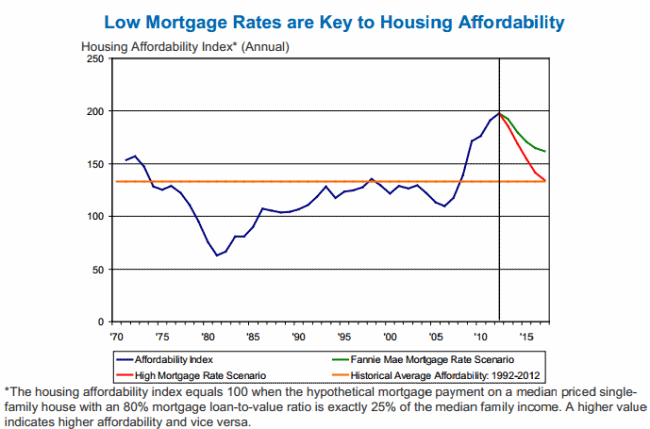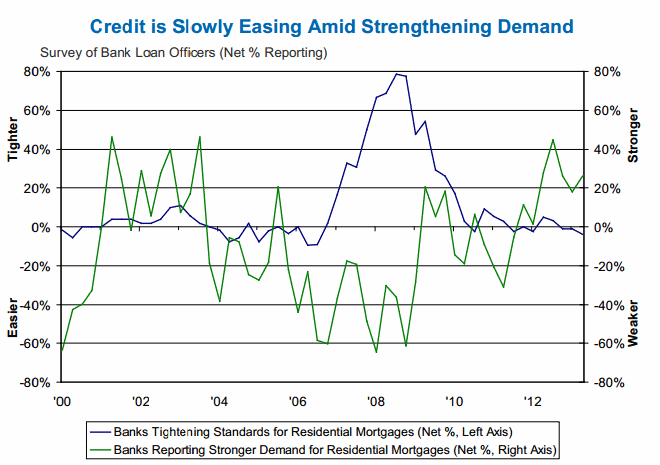Fannie Mae's economic and strategic research team today called the housing recovery "undeterred" after it contributed 0.3 percentages points to economic growth in the first quarter. Doug Duncan, Orawin T. Velz, and Brian Hughes-Cromwick said this was the eighth consecutive quarter that housing has added to growth and the company's Economic Summary for May said recent housing indicators point to continued recovery.
The annualized rate of housing starts in March was over one million units for the first time since 2008, driven solely by a surge in multi-family building which more than offset a decline in single-family construction. Multi-family housing starts are now back to the levels of the early 2000s, benefitting the report says from a continuing decline in homeownership which fell again in the first quarter to 65 percent, the lowest rate since 1995.

Existing home sales fell in March, essentially wiping out the gains in the first two months of the quarter. Sales of new single-family homes rose from February and, combined with January sales which were the strongest since April 2010, the annualized first quarter new home sales were up 51 percent, the biggest gain since 2003.

Using the one from the National Association of Realtors as a model, Fannie Mae's economists have constructed their own affordability index built on mortgage rates, family income, and home prices. The higher the index, the more affordable homes are. Of the variables, affordability is the most sensitive to changes in interest rates and the index projects that housing affordability should trend down gradually from its peak in 2012 but will remain above the level considered normal through 2017.
The analysis suggests that affordability will continue to support the housing recovery but it is no longer a primary diver of home buying. Lending standards, regulations about securitization, and housing finance reform will be future keys to a transition to normal in the housing market.

Supply side issues have contributed to the third straight decline in builder confidence in April. But builders are anticipating a better environment going forward and the declining inventories of both new and existing homes point to improving sales conditions.
These shrinking declining backlogs of homes for sale along with declining shares of distressed sales and increasing use of foreclosure alternatives are helping to boost home prices which are continuing to increase in CoreLogic indices including and excluding distressed sales. This indicates that the housing recovery is broadening across both distressed and non-distressed properties. Fannie Mae expects further price increases into the spring home buying season as inventory, though improving, remain lean.
Shadow inventories also seem to be diminishing as data from the Mortgage Bankers Association (MBA) show that seriously delinquent (90+ days) mortgages or mortgages in the process of foreclosure have declined from the record high of 9.7 percent in the fourth quarter of 2009 to 6.4 percent in Q1 2013. Overall mortgage performance has improved meaningfully; loans at least one payment past due or in foreclosure are now at a four year low of 10.3 percent.
The Report says that anecdotal evidence is pointing toward a growing sellers' market with multiple bids becoming more common. Fannie Mae's April National Housing Survey shows the nation is approaching a 'sweet spot." The share of Americans who view it as a good time to buy remains high (71 percent) while those who think it a good time to sell has doubled over the past year to 30 percent. Further supporting a sellers' market is a solidifying consumer view that prices have bottomed out. The majority now even expect prices to rise.
The mortgage lending environment has also improved. Cash sales still account for one-third of existing home sales but mortgage demand has gradually increased with the MBA's weekly survey in early May showing purchase mortgage applications at the highest level in three years.

The yield on 10-year Treasuries trended down to 1.61 percent on May 2, the lowest level for this year. Then the stronger than expected April jobs report helped boost investor risk appetites sending the yield back up to 1.90 percent at the time the summary was written. Fannie Mae expects the yield to rise gradually to nearly 2 percent by the end of 2013 and mortgages rates to average 3.7 percent in the fourth quarter of the year, remaining a strong support for the housing and mortgage market.
Fannie Mae is revising higher its projection for multifamily starts for this year and next but essentially kept the forecasts for single family starts and home sales unchanged. Multi-family starts will increase about 35 percent during the year - nearly as strong a gain as last year - and single family starts will increase about 24 percent. Total home sales should rise about 8 percent from 2012 and single family mortgage originations will fall 14 percent to $1.66 trillion in 2013 as refinancing retreats faster than purchase originations increase. Refinancing will fall to about a 63 percent share of applications (down from a current range of 72 percent) and mortgage deleveraging will come to an end as total single-family mortgage debt will rise slightly for the first time in six years.







